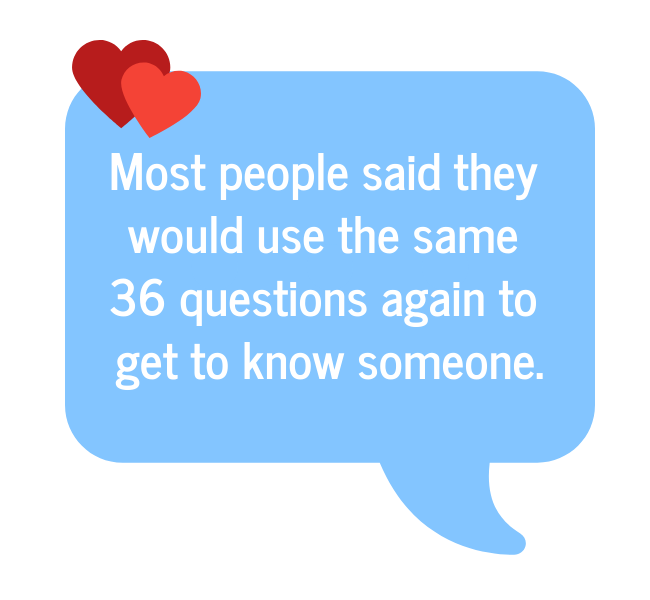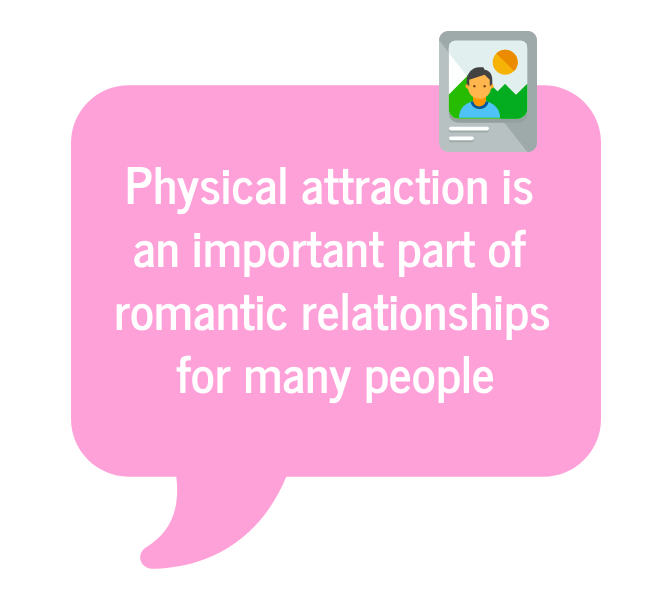If there was a way to hack love, would you try it?
The New York Times published an article titled “No. 37: Big Wedding Or Small?” The article presented a quiz comprised of 36 questions that supposedly lead to love–or, at least, an accelerated feeling of intimacy between strangers.
The idea was that if you sat down with a perfect stranger and exchanged these 36 questions, you would have shared enough intimate information with them to create a feeling of closeness in just one conversation.
The NYT article actually pulled the questions from a 1997 study led by Dr. Arthur Aron titled “The Experimental Generation of Interpersonal Closeness: A Procedure and Some Preliminary Findings.” The purpose of the study was to achieve an accelerated sense of intimacy between strangers in only 45 minutes.
We wanted to test the study but with a 21st century twist: can people fall in love through text message?
After all, most dating services involve a period of text communication between matched partners before they meet in person.
But we wanted to take it a step further: what if participants didn’t even know what their partner looked like?
According to the research done by Christian Rudder, author of Dataclysm, “photos drive 90% of the action in online dating.” [1]
Would the same study work if conducted entirely through text communication, without any physical or verbal cues?
So we matched people up entirely based on personality.
Here’s what we found:
Hover over the phone screen to scroll through the data.
Our method
Step 1: The questionnaire
We assembled a group of 32 participants ranging from 21-34 years of age. We sent them a preliminary questionnaire asking for their name, age, gender, sexual orientation, religion, and profession, as well as a number of attitudinal questions like whether or not they drink or smoke, their level of spontaneity, etc.
Step 2: Matchmaking
Once we had gathered all of their responses, we did our best to match the participants with a partner with whom they shared similar attitudes and values. None of the participants had any idea who they had been paired up with.
We then sent the participants an email instructing them to come to our office on a Wednesday evening for around two hours to participate in the study.
Step 3: The participants meet their matches through text
When the participants arrived, we pointed them to a boardroom where the WiFi connection information and refreshments were set up. We then instructed them to take a seat at an empty work station and refrain from talking to the other participants.
The participants then logged into the Slack accounts we set up for them and entered their assigned channel where they would communicate in private with their partner.
We gave the participants the following instructions (adapted from the instructions provided in the original study):
“You will be paired with another person in this room whom you don’t know. (We have matched you, based on the questionnaire you completed prior to arriving here, with someone we think will like you and whom you will like). The purpose of this exercise is to form a sense of intimacy between you and your partner at an accelerated pace.
Once the conversation period begins you may exchange names with your partner. Over 45 minutes, you and the person we have paired you with will talk about a series of particular topics designed to help you get close. Your conversation will be conducted entirely through text chat, with no physical interaction. Please refrain from looking around at other participants to figure out who your partner is–we want to keep it anonymous until the end of the conversation period.
At the end of the conversation period, you will have the option of exchanging contact information with your partner over text chat. After that, you will be given 10 minutes to individually complete a post-conversation questionnaire reflecting on your experience.
If you would like a drink refill or more food, please put raise your hand and we can get it for you, so as not to alert your partner of who you are.”
We set the timer for the first 15 minutes and the room immediately filled with the sound of fingers clacking on keyboards. As the participants chatted, we looked around at their faces: many of them with brows furrowed in concentration and many of them smiling.
A minor adjustments to the study
During a bathroom break in the middle of the study, some of the participants complained that 15 minutes was not enough time to respond to the questions in as much detail as they would like.
Since it was taking people considerably longer to type out their responses than if they were to exchange them verbally, we decided to provide participants an extra 10 minutes to complete the third and final set of questions.
This culminated in a total question period of 55 minutes, instead of the original 45 minutes.
Step 4: The matches meet in person
Once the conversation period was over and they had completed their post-conversation questionnaires, participants had the opportunity to seek out their partners in the room.
Some people made a beeline for the door, clearly not excited to meet their partners. But many of the participants did find their partners. One couple even left together to get a drink and continue their conversation, this time with the nuance of physical cues.
Results: can you “fall in love” with someone through text message?
Did anyone fall truly, madly, deeply in love after their 55 minute conversation?
Well, probably not.
But 81% of the participants did exchange contact information at the end of the conversation period–and when asked to rate the likelihood that they would contact their partner after the study, 47% answered very likely.
In the original study conducted by Dr. Arthur Aron, after 45 minutes of interaction, the relationship of partners was rated closer than the closest relationship in the lives of 30% of similar students.
Our results showed that our study did not achieve that same level of closeness.
After 55 minutes of text messaging:
- 16% of participants reported feeling the same level of closeness to their partner as they do to the closest person in their life,
- 84% reported feeling less close in comparison,
- and 0% reported feeling more close in comparison.
So it would appear that the lack of physical cues did, in fact, prevent participants from feeling very close to one another. But that doesn’t mean that participants didn’t enjoy the experience.
When asked if they found discussing personal topics over text easier than in person:
- 13% of participants found the restrictions difficult,
- 37% of participants expressed ambivalence when it came to conversation through text versus in person,
- and the remaining 50% of participants actually found it easier to discuss personal topics through text.
![]()
This probably doesn’t come as a surprise to a lot of people.
One participant wrote in their post-conversation questionnaire, “Without the feeling of judgement with facial expressions it was easier to be honest.”
Another participant, however, wrote that they found the experience, “Frustrating. It’s hard to get a real sense of the person [and it’s] hard to strive for genuineness when you can’t read their underlying tone.”
Another woman commented that by discussing personal topics right at the get-go, it was easier to go backwards to small talk in person because she already had context–“it’s like lubrication [for the conversation].” She appreciated having intimate information about her partner to draw on because she doesn’t like small talk and hates awkward lulls in conversations.
In-person conversation is still preferred by most people
Despite the majority of participants either preferring (50%) or feeling ambivalent towards discussing personal topics through text (37%), when it comes to interactions in general, the majority of participants (53%) still preferred interacting with people in person.
It seemed that while it may be easier to get into personal topics when you’re not facing your partner, most people would not want their interactions to stay strictly electronic.
What’s more, many of those that were interested in their partner after the conversation still expressed a desire to interact with their partner in person before passing any judgements.
Multiple participants also commented in their questionnaires that the 15 minute time limits drastically restrained their conversations. What is surprising is that there is no mention of the time limit being a particular hindrance to the participants in the original study.
This suggests a couple of things:
- It takes longer to communicate through text (many people type more slowly than they speak).
- People are more preoccupied with how they word things when communicating through text than when communicating verbally.
- Answers require more explanation and thought when communicated through text than in person with accompanying physical cues.
One woman speculated that she probably would not have felt so pressured by the time limit if she had chatted with her partner in person because their facial cues would have made up for short or incomplete answers. She found herself worrying over whether her partner found her answers too short or her transitions between topics too abrupt or rude.
She found it easier to give people more credit for their pauses and unfinished thoughts when you can see their facial expressions than when you’re sitting there waiting for their next typed-out response.
Results from our follow-up questionnaire
We sent out a questionnaire to the participants one week later to see if anyone had followed up with their partners after the study (27 people got back to us).
We asked them if they had talked to their partner since the day of the study, if they had done something with them in person, and if they planned on maintaining communication with them moving forward.
How many participants talked to their match after the study?
While about half of the participants (48%) had a conversation with their partner in the week after the study, and about a quarter (25%) had more than one conversation, the majority of participants did not intend to see their partner again in the future (78%).
For some, it was simply a matter of not feeling enough attraction in person to pursue their partner.
One person admitted to simply being “too lazy” to bother keeping in contact. Most participants said that they would consider using the questions again but in person, or that they would consider pulling some of the questions and using them as ice breakers, rather than going through the entire set of 36 questions.
Only seven participants said that yes, they would use the 36 questions over text again.
When it comes to romance, for most people, physical chemistry is too important to overlook.
But it wasn’t all for nothing. When we followed up with one of the participants, she had this to say:
We also received this email from another participant (who asked to remain anonymous):
If anything, at least the whole experience was weird enough to bring a few perfect strangers closer together.
What can we take away from these online dating statistics?
So our results show that text-only conversation actually acts as a barrier when attempting to reach accelerated closeness, despite making it easier for more reserved people to discuss personal topics.
Multiple participants noted in their post-conversation questionnaires that physical attraction is an important aspect of their romantic relationships. A person’s facial expressions can reveal things about them that text can’t.
If we had asked participants to even just show a photo of themselves to their partner, the conversations and responses would probably have been different.
Meeting in person still matters to most people
While online dating services are an effective way for people to get in touch with potential matches, in order for relationships to progress to something more, most people still require face-to-face interaction.
That being said, participants told me that they appreciate the sort of screening process of chatting online before deciding to meet someone in person.
After the study, one man told me that his longest lasting relationships in the past involved a longer period of texting before they actually met in person.
More couples are meeting online each year
Across the board, studies show that more and more couples are meeting online each year.
A 2017 study by The Knot found that 19% of brides met their spouses through online dating. This is compared to a 2010 Match.com survey which reported that 17% of couples met online.
Those numbers are projected to grow–according to research done by eHarmony, 38% of couples are expected to meet online in the near future, with that number rising to 70% of couples by 2040.
One factor remains the same, though: when looking for love, people generally seem to regard online dating as a gateway to in-person interaction. Text conversation is enough to pique most people’s interest, but until they meet them in person, they generally don’t know for certain how they feel about their matches.
[1] Modern Romance by Aziz Ansari, 2015. Page 97.



















































